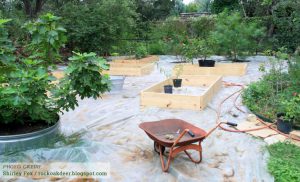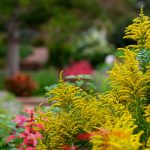Using the summer sun (solarization) as a process of weakening or killing unwanted plants by harnessing the sun’s intensity. And summertime — in the full scorch of the sun — is the best time to use this method.
So, you want to replace your thirsty lawn with a productive, colorful garden? Great choice! You want to kill the grass and weeds without using chemical means? Nice!
If you envision a low-maintenance garden without pesky, persistent weeds and grass, with some skill, patience and conviction you can achieve all of the above using solarization. And summertime — in the full scorch of the sun — is the best time to use this method.
Solarization is a method of weakening or killing unwanted plants by harnessing the sun’s intensity. An old trick used in the green industry to kill weed seeds and soil borne pathogens, the solarization process involves using a layer of clear plastic over an area of land to create the greenhouse effect on steroids.

Photo Credit: Shirley Fox / rockoakdeer.blogspot.com
What you need:
- Stakes and string or marking paint.
- A functioning sprayer, 20 percent vinegar and garden-grade orange oil.
- A roll of 4-6 mil plastic large enough to cover your intended garden area.
- Enough bricks, rocks or lumber to completely surround the delineated area.
How to do it:
- Outline and define the area to be developed. Use marking paint, string and stakes, your hose or any material that you have lying around to help you define the garden borders.
- Spray the area with the vinegar and orange oil solution (vinegar, undiluted, with a capful of orange oil). Wait three to four days or until you see weeds turning wilted and brown. Mow the area at the lowest setting then go an extra step and scalp the area with a weed eater. I find this step especially satisfying when the culprit is a certain exotic lawn grass species.
- Soak the area with water unless, of course, we’ve just had a nice rain.
- Lay the plastic over the designated area. You may cut the plastic to the shape of your future garden bed. Be sure to keep an eye on the plastic especially toward the end of the time period. Thinner plastic will photodegrade more quickly and begin to rip apart in tiny pieces. This gets messy and you will be picking up tiny pieces of plastic instead of moving forward with your garden.
- Place bricks, lumber or rocks around the perimeter of the plastic to create a seal and keep the plastic from blowing away. This seal is very important as it keeps the intense heat trapped underneath the plastic layer.
- Allow the plastic to remain in place for four to six weeks. Tough perennial species will take longer to kill.
- Check the area periodically to monitor progress. Leave the plastic as long as possible until weeds are brown and dead.
- Remove the plastic.
- Hand-till the area in preparation for planting and then allow a couple of weeks to monitor for any sprouts or signs of remaining perennial weed species.
- Blast survivors or returning weeds with the vinegar and orange oil mixture. Replace the plastic for at least another three weeks.
- Remove the plastic, add a layer of compost, till lightly and take joy in planting your new chemical-free garden!
This method works best in full sun and during the hottest time of the year so even when it’s too hot to tackle garden chores, the San Antonio summer can actually help you be productive. It’s a bit of a time investment, but could save you hours of backbreaking weeding after your garden is planted.

Michelle Gorham is a local horticulturist and owner of Wallflower Farm and Garden. She arrived in Texas in 1999, fell in love with the native plant movement and acquired a passion for ecologically-based landscape design and community-created garden projects. As the owner of Wallflower Farm and Garden, she employs 25 years of horticultural knowledge that developed through her education, work experience, and desire to help people connect with nature.
Wallflower Farm and Garden specializes in residential landscape design, consultation, and maintenance that creates productive, garden experiences for humans and other living creatures.
She lives with her husband, daughter and many four-legged and feathered beings on the southern reach of the San Antonio River where they are nurturing their piece of urban land using permaculture principles.




